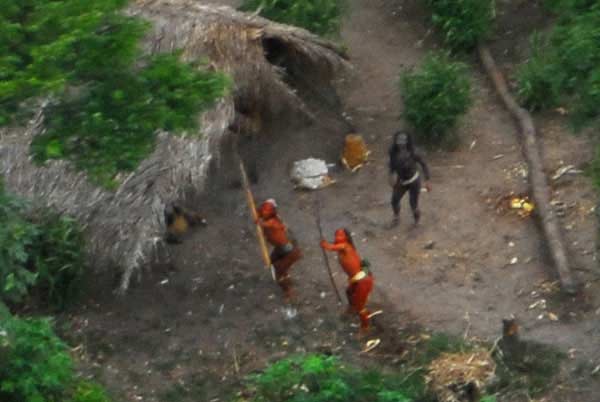Photo of Amazon Tribe Not a Hoax

Recent photos of an "uncontacted tribe" of Indians near the Brazil-Peru border have sparked media reports of a hoax, but the organization that released the images defends its claims and actions.
The photographs, which showed men painted red and black and aiming arrows skyward, were released in late May by Survival International, a London-based organization that advocates for tribal people worldwide. The release stated that "members of one of the world's last uncontacted tribes have been spotted and photographed from the air," and quoted the Brazilian government photographer saying, "there are some who doubt [the tribe's] existence" as justification for flying over the site and taking the pictures.
Some of the media published the images at the time with stories saying the tribe previously had been "lost." In fact, a LiveScience column stated that the tribe had "escaped discovery" until the new photos came out.
This week, suspicions about the organization's motivations and the authenticity of the scene were raised. On June 22, The Observer, a London-based newspaper, ran a story, "Secret of the 'lost' tribe that wasn't," saying that the tribe's existence "has been noted since 1910." A succession of other stories followed on the Web, claiming that reports of the tribe's discovery were a hoax.
No hoax
Today, Survival International released a statement to try to clarify things, including: "The story is not a hoax, and none of those involved in working to protect these Indians' rights have ever claimed they were 'undiscovered.'"
Survival never claimed that the tribe was lost. The story got out of control, says Fiona Watson, Survival's Brazil expert, as a result of irresponsible reporting.
Sign up for the Live Science daily newsletter now
Get the world’s most fascinating discoveries delivered straight to your inbox.
"Some of the media got very carried away and started talking about undiscovered tribes," Watson told LiveScience. "There was this interpretation that this was a completely new tribe, completely undiscovered, without bothering to check with sources. Neither the Brazilian government nor Survival has ever used that word, and 'uncontacted' means they don't have any contact with outsiders."
Survival International's Web site includes a page about "uncontacted tribes," here, which states that more than 100 uncontacted tribes are known worldwide, with more than half living in either Brazil or Peru. These tribes, "whilst not 'lost,' simply reject contact with the outside world," according to Survival's statement today.
Survival campaigns to protect the tribes' land.
The recently photographed tribe might have had contact with neighboring tribal groups, Watson said, adding, "We don't know. They almost certainly know about the outside world. We mean 'having no physical contact,' living in a very isolated way in the Amazon."
"Flying over in an airplane doesn't constitute contact," she said.
The Observer journalist failed to do his homework, Watson said. If he had, "he would have seen that we've been talking about the existence of the tribe for some time now. Of course we know they are there, but there has been no contact," Watson said.
Respecting rights
Watson agreed that the Brazilian government has known about the tribe since 1910, and said the government has had a policy of no contact with the tribe since 1988 in an effort to protect them from illnesses.
"It's about respecting their rights to live their lives as they want to, letting them get on with their lives," she said. "In 20 years, they may decide they do want to come out of the forest, but that's for them to decide. It's about protecting the land and letting them live as they wish to."
The photos were taken to prove to the Peruvian government that the Brazilian tribe exists because there have been challenges controlling illegal logging near the border and the logging might be pushing Peruvian tribes into Brazil and into conflict over resources with Brazilian tribes, Watson said.
The photos have had a positive effect already, she said. The Peruvian government has since "formed a commission of experts to look into the illegal logging and into the status of the uncontacted groups on the Peru side," Watson said.
And would Survival International do anything differently with the recent photo campaign, if they had it to do over? "Nope," said Survival's Miriam Ross.
- The Most Popular Myths in Science
- Top 10 Unexplained Phenomena
- Alien Encounters Debunked
Robin Lloyd was a senior editor at Space.com and Live Science from 2007 to 2009. She holds a B.A. degree in sociology from Smith College and a Ph.D. and M.A. degree in sociology from the University of California at Santa Barbara. She is currently a freelance science writer based in New York City and a contributing editor at Scientific American, as well as an adjunct professor at New York University's Science, Health and Environmental Reporting Program.










